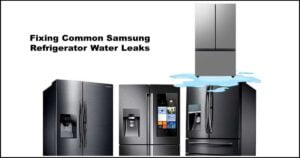When your Samsung refrigerator displays an error code, it can be alarming. But don’t worry; these codes are there to help you troubleshoot the problem. This blog post will explain some of the most common Samsung refrigerator error codes, what they mean, and how to fix them.

Common Samsung Refrigerator Error Codes
AP: Access Point.
- This code means your refrigerator is acting as an access point for Wi-Fi features like SmartThings. It will disappear once the setup is complete.
21E, 21C: Freezer Fan Error.
- This code indicates the freezer fan isn’t working properly. It could be frozen due to a door left open or a faulty fan motor. Try defrosting the unit or checking the door gasket for a proper seal.
22E, 22C: Fridge Fan Error.
- This code suggests an issue with the fridge fan, possibly due to the door being left open for too long. Unplug the refrigerator, leave the doors open for a few hours, then restart and close the doors securely.
41 or 42 with flashing interior blue lights:
- Reboot the Family Hub using the power switch.
41E, 41C: Software update is required.
- Update the software on your Family Hub model.
76E, 76C, or blinking autofill indicator:
- Water is detected in the autofill compartment.
85E, 85C: Low voltage detected.
- Press OK for 3 seconds to clear this error.
88 88, 83E, 85E, or 86E: Voltage or Power Error.
- Unplug the refrigerator for 60 seconds and restart it.
PC ER, PC CH: Communication Error.
- Unplug the refrigerator, reconnect the wire harness above the door, and then restore power.
OF OF or O FF: Cooling Off Mode.
- This is a demo mode and not an error. Refer to your user manual to turn it off.
All icons flashing after being plugged in or a power outage:
- The refrigerator is running a self-diagnosis test. This is normal.
Ice Off blinking:
- The ice bucket is not inserted correctly.
Other Samsung Refrigerator Error Codes:
This blog post only covers a few common error codes. Here’s a more complete list:
Freezer Sensor Error (1C, 1E, or 1):
This code indicates a problem with the sensor that monitors the temperature inside your freezer. It could be faulty wiring, a malfunctioning sensor, or the sensor reading temperatures outside the normal range (-58°F/-50°C to +122°F/+50°C).
Fridge Sensor Error (2C or 2E):
Similar to the freezer sensor error, this code signifies an issue with the sensor tracking the temperature within your refrigerator compartment. Troubleshooting steps are the same as for the freezer sensor error.
Defrost Sensor Error (3C or 3E):
This code is more general and indicates a malfunction with the defrost sensor, which plays a role in regulating the automatic defrost cycle. The sensor could be open, shorted, or reading temperatures outside the expected range.
Freezer Defrost Sensor Error (4C or 4E):
This code pinpoints a specific issue with the sensor responsible for monitoring defrosting within the freezer compartment. It likely means the sensor is open, shorted, or reading abnormal temperatures.
Fridge Defrost Sensor Error (5E or 5C):
This 5E/5C error code signifies a problem with the sensor that tracks defrosting cycles in the fridge section. Troubleshooting steps are the same as for the freezer defrost sensor error.
Ice Maker (Freezer) Sensor Error (8E or 8C):
This 8E/8C error code indicates a malfunction with the sensor monitoring the temperature within the ice maker in the freezer.
Ice Maker Sensor Error (14E or 14C):
This code is broader than 8E and suggests a general problem with the ice maker sensor, not necessarily related to temperature.
Ice Pipe Heater Error (33E, 33C):
This code signifies a malfunction with the heating element responsible for melting ice during the dispensing process.
Ice Maker Function Error (39E, 39C):
This code indicates a general issue with the ice maker’s functionality, not necessarily related to a sensor.
Ice Room Fan Error (40E, 40C):
This code suggests a problem with the fan circulating air within the ice compartment. The fan could be malfunctioning or blocked with frost.
Compressor Lock (84E or 84C):
This code is a serious one and indicates a compressor lockup. The compressor is the heart of your refrigerator’s cooling system, and a lockup means it’s unable to circulate refrigerant properly.
By understanding Samsung refrigerator error codes, you can troubleshoot minor issues and keep your refrigerator running smoothly.
Remember, if you see an error code not mentioned here, consult your repair manual.







